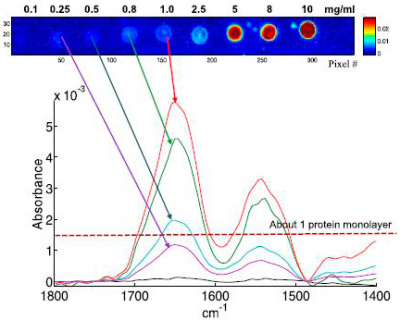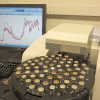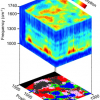
By using Fourier Transform Infrared Spectroscopy (FT-IR), researchers at the Center for Structural Biology and Bioinformatics, Université Libre de Bruxelles, Brussels, Belgium, can greatly increase the amount of information that can be extracted from a protein microarray. In a new report in Biomedical Spectroscopy and Imaging, they show how high-quality spectra can be obtained from spots of protein no larger than the diameter of a human hair.
The common use of protein microarrays requires the binding of proteins to other compounds such as therapeutic drugs. A fluorescent molecule is attached to the protein so that if binding with the drug occurs, there will be a light signal from the bound pair. However, these fluorescent proteins can be difficult and expensive to produce, and the information is limited to determining whether the drug binds or not.
Researchers created microarrays using a commercial tool in which about 100 pL of protein were deposited from solution. The resulting spots of protein were about 100 µm in diameter. A 128 × 128 focal-plane-array was used to collect a full IR spectrum from each of the spots in the array, resulting in 16,384 complete spectra. These spectra were pre-processed to remove random noise and perform background correction.
In order to test the sensitivity of the method, lysozyme, albumin and haemoglobin solutions were prepared at concentrations from 10 mg mL–1 to 0.1 mg mL–1 and deposited in multiple spots. Single spots provided structural and concentration information from a typical protein, albumin.
According to lead investigator Erik Goormaghtigh, PhD, the combination of FTIR and microarray technology has three main advantages.
- Label-free detection: Labelled proteins may be not commercially available or very expensive. It also enhances quality because the labelling procedure often destroys part of the protein structure.
- Direct and absolute quantification of proteins: Infrared detection can quantify the amount of bound protein in a sample.
- Full imprint of proteins: Infrared imaging provides a complete vibrational spectrum of the binding molecule, which includes information on chemical reactions and protein secondary structure.
“The results of this study show that high quality spectra can be obtained from minute amounts of proteins, i.e. below a single monolayer of proteins”, explained Dr Goormaghtigh. “This is important as it opens the way to use infrared imaging, instead of fluorescence for instance, for detection of binding. This work also shows that it is now possible to produce high throughput protein analysis by combination of microarrays technology and infrared spectroscopy imaging allowing hundreds of proteins to be quantitatively analysed in a few minutes. The whole process from protein production/purification to microarray analysis is now integrated in a high throughput robotic platform called Robotein.”
“The study by Goormagtigh and co-workers will further enhance the usefulness of FT-IR spectroscopy for protein pharmaceuticals and proteomics research. The approach will nicely complement and supplement existing techniques, used for protein characterisation, such as CD, NMR and mass spectrometry”, commented Biomedical Spectroscopy and Imaging Editor-in-Chief Dr Parvez I. Haris, Faculty of Health & Life Sciences, De Montfort University, UK.








